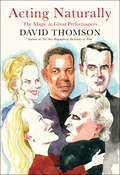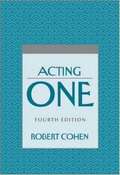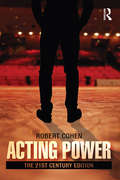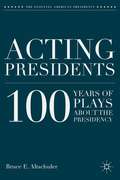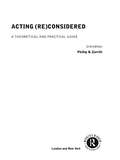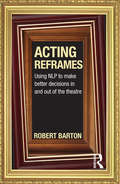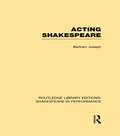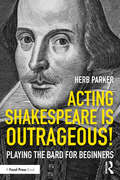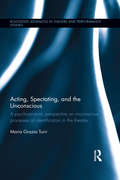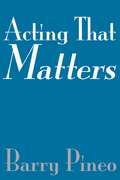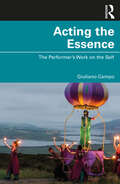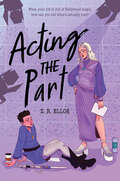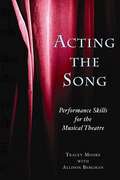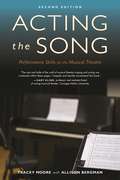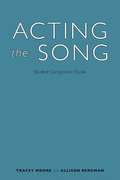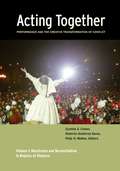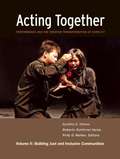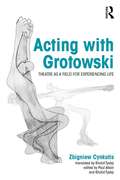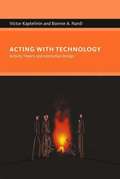- Table View
- List View
Acting Like a Women in Modern Japan: Theater, Gender, and Nationalism
by Ayako KanoWeaving together careful readings of plays and reviews, memoirs and interviews, biographies and critical essays, Acting Like a Woman in Modern Japan traces the emergence of the first generation of modern actresses in Japan, a nation in which male actors had long dominated the public stage. What emerges is a colorful and complex picture of modern Japanese gender, theater, and nationhood. Using the lives and careers of two dominant actresses from the Meiji era, Kano reveals the fantasies, fears, and impact that women on stage created in Japan as it entered the twentieth century.
Acting Naturally: The Magic in Great Performances
by David ThomsonFrom the celebrated film critic and author of The New Biographical Dictionary of Film, a fascinating look at some of the cinema&’s finest actors and how they approach their craft"Open to any page and you&’ll become enthralled by the...tales of forgotten film lore, childhood memories, sexy gossip.&”—Philip Kaufman, directorMeryl Streep, Marlon Brando, Anthony Hopkins, Carey Mulligan. When we watch these remarkable actors in a performance, we see only Sophie, Stanley Kowalski, Hannibal Lecter, or Cassie from Promising Young Woman. How are they able to transform our world in this way? How and why do they do what they do?In Acting Naturally, David Thomson sheds light on the actors who have shaped the film industry. He shrewdly analyzes these stars—among them, James Dean, Nicole Kidman, Denzel Washington, Louise Brooks, Riz Ahmed, Sir Laurence Olivier, Viola Davis, and Jean Seberg—revealing how a sly smile, an extra-long pause, even a small gesture of the hand can draw in an audience. And he takes us behind the scenes to examine casting and all the other moments leading up to &“Action!&”Through intimate anecdote, humor, and the insight born of a lifetime watching and analyzing film, Thomson explores the real reasons why we go to the movies and looks at how they influence our lives. This book is not only necessary reading for an insider&’s view of the industry but also a surprising investigation of the relationship between acting and living.
Acting on Cultural Policy: Arts Practitioners, Policy-Making and Civil Society (New Directions in Cultural Policy Research)
by Jane WoddisThis book investigates the role of arts practitioners in cultural policy-making, challenging the perception that arts practitioners have little or no involvement in policy and seeking to discover the extent and form of their engagement. Examining the subject through a case-study of playwriting policy in England since 1945, and paying particular attention to playwrights’ organisations and their history of self-directed activity, the book explores practitioners’ participation in cultural policy-making, encompassing both “invited” and “uninvited” interventions that also weave together policy activity and creative practice. It discusses why their involvement matters, and argues that arts practitioners and their organisations can be understood as participants in civil society whose policy activity contributes to the maintenance and enlargement of democratic practices and values.
Acting One (4th edition)
by Robert CohenUsed to teach beginning acting on more campuses than any other text, Acting One contains twenty-eight lessons based on experiential exercises. The text covers basic skills such as talking, listening, tactical interplay, physicalizing, building scenes, and making good choices.
Acting Power: The 21st Century Edition
by Robert Cohen‘Robert Cohen’s book, Acting Power, follows the tradition of his other book, Acting One, and has been the veritable bible for acting teachers for the last quarter century.’ – David Krasner, Emerson College ‘This book, above all else, is an attempt to explore the qualities of acting power.... to suggest to you, the actor, an approach toward not merely good acting but powerful acting. Great actors display the power to frighten – and the power to seduce – and can shift between the one and the other like a violinist can her notes.’ – From the Preface The first edition of Acting Power was a groundbreaking work of acting theory which applied sociological and psychological principles to actor training. The book went on to influence a generation of theatre and performance studies students and academics, and was translated into five languages. This carefully revised 21st Century Edition (re)considers, in the context of today’s field: questions such as ‘should actors act from the inside or the outside?’ and ‘should the actor live the role or present the role?’; contemporary research into communication theory, cybernetics, and cognitive science; brilliantly illuminating and witty exercises for solo study and classroom use, and a through-line of useful references to classic plays; penetrating observations about the actor’s art by more than 75 distinguished professional actors and directors. Cohen’s elegant and rigorous updates emphasise the continuing relevance of his uniquely integrated and life-affirming approach to this field. The new edition draws on his extraordinarily rich career as teacher, scholar, director, translator and dramaturg. It is a recipe for thrilling theatre in any genre.
Acting Presidents
by Bruce E. AltschulerThis book seeks to fill a major gap in the literature about fictional representations of presidents by studying more than 40 plays, written since 1900, which have had prominent productions on or off-Broadway or in another major city.
Acting Queer: Gender Dissidence and the Subversion of Realism
by Conrad AlexandrowiczThis book is situated at the intersection of queer/gender studies and theories of acting pedagogy and performance. It explores the social and cultural matrix in which matters of gender are negotiated, including that of post-secondary theatre and drama education. It identifies the predicament of gender dissident actors who must contend with the widespread enforcement of realist paradigms within the academy, and proposes a re-imagining of the way drama/theatre/performance are practised in order to serve more fairly and effectively the needs of queer actors in training. This is located within a larger project of critique in reference to the art form as a whole. The book stimulates discussion among practitioners and scholars on matters concerning various kinds of diversity: of gender expression, of approaches to the teaching of acting, and to the way the art form may be imagined and executed in the early years of the 21st Century, in particular in the face of the climate crisis. But it is also an aid to practitioners who are seeking new theoretical and practical approaches to dealing with gender diversity in acting pedagogy.
Acting (Re)Considered (Re)Considered: A Theoretical and Practical Guide
by Phillip B. ZarrilliActing (Re)Considered is an exceptionally wide-ranging collection of theories on acting, ideas about body and training, and statements about the actor in performance. This second edition includes five new essays and has been fully revised and updated, with discussions by or about major figures who have shaped theories and practices of acting and performance from the late nineteenth century to the present.The essays - by directors, historians, actor trainers and actors - bridge the gap between theories and practices of acting, and between East and West. No other book provides such a wealth of primary and secondary sources, bibliographic material, and diversity of approaches. It includes discussions of such key topics as:* how we think and talk about acting* acting and emotion* the actor's psychophysical process* the body and training* the actor in performance* non-Western and cross-cultural paradigms of the body, training and acting.Acting (Re)Considered is vital reading for all those interested in performance.
Acting Reframes: Using NLP to Make Better Decisions In and Out of the Theatre
by Robert BartonActing Reframes presents theatre and film practitioners with a methodology for using Neuro-Linguistic Programming (NLP) as a tool to aid their practice. Author Robert Barton uses the NLP approach to illustrate a range of innovative methods to help actors and directors, including: • reducing performance anxiety • enabling clearer communication • intensifying character analysis • stimulating imaginative rehearsal choices. The author also shows how NLP can used alongside other basic training systems to improve approaches to rehearsal and performance. The book shows the use of NLP to the reader in a playful, creative and easily accessible style that is structured to enable solo study as well as group work. The text offers a range of engaging exercises and extensive analysis of language patterns used in performance. It is a source for enhancing communication between all theatre practitioners in training, productions, and daily life outside the theatre. Acting Reframes gives actors a richly rewarding approach to help them develop all aspects of their craft.
Acting Shakespeare (Routledge Library Editions: Shakespeare in Performance)
by Bertram Leon JosephHow did the actors for whom Shakespeare wrote his plays make his characters come to life, how did they convey his words? Can modern directors, actors, and even library readers of Shakespeare learn from them? Creating character and making the Elizabethan playwright’s poetry compelling for the audience is a problem which has seldom been resolved in modern times. This book demonstrates the hard course a modern actor must follow to make real and truthful the words he speaks, and the action and emotion underlying them. With examples and simple exercises, this book helps with the preparation for the great task – providing the actor with a combination that unlocks the Bard's English. Starting with how theatrical speech was understood in Renaissance England, it looks at figures of speech, the powers of persuasion, and the passion and rhythm inherent in the language.
Acting Shakespeare is Outrageous!: Playing the Bard for Beginners
by Herb ParkerPerforming the work of William Shakespeare can be daunting to new actors. Author Herb Parker posits that his work is played easier if actors think of the plays as happening out of outrageous situations, and remember just how non-realistic and presentational Shakespeare's plays were meant to be performed. The plays are driven by language and the spoken word, and the themes and plots are absolutely out of the ordinary and fantastic - the very definition of outrageous. With exercises, improvisations, and coaching points, Acting Shakespeare is Outrageous! helps actors use the words Shakespeare wrote as a tool to perform him, and to create exciting and moving performances.
Acting, Spectating and the Unconscious: A psychoanalytic perspective on unconscious mechanisms of identification in spectating and acting in the theatre. (Routledge Advances in Theatre & Performance Studies)
by Maria Grazia TurriFrom Aristotle’s theory of tragic katharsis onwards, theorists of the theatre have long engaged with the question of what spectatorship entails. This question has, directly or indirectly, often been extended to the investigation of acting. Acting, Spectating, and the Unconscious approaches the unconscious aspects of spectatorship and acting afresh. Interweaving psychoanalytic descriptions of processes such as transference, unconscious phantasy, and alpha-function with an in-depth survey of theories of spectating and acting from thinkers such as Brecht, Diderot, Rousseau and Plato, Maria Grazia Turri offers a significant insight into the emotions inherent in both the art of the actor, and the spectator’s experience. A compelling investigation of the unconscious communication between spectators and actors, this volume is a must-read for students and scholars fascinated by theatre spectatorship.
Acting Techniques for Everyday Life: Look and Feel Self-Confident in Difficult, Real-Life Situations
by Jane Marla RobbinsMost people can name at least one situation?a business presentation, a job interview, a cocktail party, or a blind date?in which they felt uncomfortable, nervous, or simply self-conscious. Jane Marla Robbins, a successful stage and film actress and teacher for almost forty years, found that she could use the same acting techniques she employed to look and feel confident on stage and screen to make herself feel more comfortable in ?real-lifeOCO situations. In clear and accessible language, Robbins describes acting techniques that actors having been using for centuries and explains?using real-life examples and easy-to-follow exercises?how each can be used by ordinary people to make difficult everyday situations easier to handle. Acting Techniques for Everyday Life will teach readers how to create a sense of well-being and self-confidence at will, giving them the tools they need to be as confident, strong, witty, authentic, relaxed, and happy as they want to be in any given situation. "
Acting That Matters
by Barry PineoAn invaluable resource for anyone wanting his or her acting to matter, this groundbreaking guide defies most modern acting methods by rejecting emotion as an acting tool. With the advice in this book, actors will see beyond the prevailing "objective-obstacle" approach and look primarily to the text the playwright provides. Actors learn how to dissect a text for key words and phrases, as well as how to score a script, find proper tempo and rhythm, modulate volume and intensity, use theatrical stillness effectively, find beat actions, listen to their acting partners, and much more. Expert tips are also provided for auditioning, cold reading, and taking direction.
Acting the Essence: The Performer's Work on the Self
by Giuliano CampoActing the Essence examines the theory, practice, and history of the art of the performer from the perspective of its inner nature as work on oneself, within, around, and beyond the pedagogy of the actor. Ref lecting primarily on the legacy of Jerzy Grotowski, this book is composed of a series of ref lections on the Stanislavskian lineage of practitioners and related authors, in an attempt to revive awareness of the original path traced by the Russian master and to refine certain ambiguities in contemporary training. In a new media age of image and sound, accompanied by a proliferation of new technologies and means to communicate, emphasised by the COVID-19 crisis, a classic question comes to be asked of us again: What is the essence and the principal objective of the work of the performer? Is performing art still necessary? While proposing a theoretical advancement of the discipline and an historical overview of the relevant practices, this book provides tools for a better understanding of the traditional function of the performer’s practice as work on the self, for its ecological renaissance through a conscient use of trance, attention, and altered states of consciousness. This book offers insight for students in drama, theatre, and performance courses studying acting and performance at university.
Acting the Part
by Z.R. EllorThis delightfully tropey teen romance perfect for fans of Ashley Poston and Lyla Lee follows a queer teen actor navigating their gender identity—while pretending to date their co-star. Queer actor Lily Ashton has found fame playing lesbian warrior Morgantha on the hit TV show Galaxy Spark. Lily knows how little representation queer girls have, so when the showrunners reveal that Morgantha’s on-screen love interest, Alietta, is going to be killed off, Lily orchestrates an elaborate fake-dating scheme with the standoffish actress who plays her, to generate press and ensure a happy ending for the #Morganetta ship.But while playing a doting girlfriend on- and off-screen, Lily struggles with whether a word like “girl” applies to them at all.Lily’s always been good at playing a part. But are they ready to share their real self, even if it means throwing everything they’ve fought for away?
Acting the Song: Performance Skills for the Musical Theatre
by Tracey Moore Allison BergmanActing the Song offers a contemporary, integrated approach to singing in musicals that results in better-trained, smarter performers who can use song to add drama and dimension to their roles. Directors, teachers of musical theater, and students--including actors, singers, or dancers--will find time-tested advice, exercises and worksheets for all skill levels. This book guides readers through musical theater elements, classroom workshops, and the world of professional auditions and performances. Chapters cover vocal and physical warm-ups, body movement, finding subtext, creating a character, song structure, interpreting text of music and lyrics, risks and spontaneity, memorization, collaboration, keeping a performance fresh, and much more. Both teachers and students will appreciate the sections for beginning, intermediate, and advanced performers. Everyone involved in musical theater, from new students to working professionals, will benefit from this rich resource.
Acting the Song: Performance Skills for the Musical Theatre
by Tracey Moore Allison BergmanActing the Song offers a contemporary, integrated approach to singing in musicals that results in better-trained, smarter performers everyone wants to work with. In this new, thoroughly updated edition of the paperback, directors and teachers of musical theater will find guidance in developing and leading musical theater elements, classroom workshops, and the world of professional auditions and performances. A companion ebook specifically for students-including actors, singers, or dancers-contains time-tested advice, exercises, and worksheets for all skill levels, with links to additional resources online. Subjects for both versions cover:Singing and acting terminologyUse of microphones, recording devices, and other technologyVocal and physical warm-ups, movements, and gesturesCreating a characterFinding subtext, interpreting music and lyrics, and song structureCollaborating with other actorsKeeping a performance fresh and newUsing social media and online audition sitesTeachers and students alike will appreciate the sections for beginning, intermediate, and advanced performers. Covering all changes to the industry, education, music styles, and audition protocols, everyone involved in musical theater, from new students to working professionals, will benefit from this rich resource.Allworth Press, an imprint of Skyhorse Publishing, publishes a broad range of books on the visual and performing arts, with emphasis on the business of art. Our titles cover subjects such as graphic design, theater, branding, fine art, photography, interior design, writing, acting, film, how to start careers, business and legal forms, business practices, and more. While we don't aspire to publish a New York Times bestseller or a national bestseller, we are deeply committed to quality books that help creative professionals succeed and thrive. We often publish in areas overlooked by other publishers and welcome the author whose expertise can help our audience of readers.
Acting the Song: Student Companion Ebook
by Tracey Moore Allison BergmanUsed in tandem with Acting the Song: Performance for the Musical Theatre, this Student Companion Ebook guides students through three semesters (beginning, intermediate, and advanced) of musical theatre song study. It answers the many questions students using this method may have, including some that they may be reluctant to ask-about fear, handling criticism, understanding their type, dealing with bad auditions, and the best use of social media, among others. Worksheets completed by real-life students can be used as models of best practice and will serve to inspire students to dig deeply and explore their own thoughts about the songs.Teachers using Acting the Song will find this ebook companion indispensable, and students will come to class more prepared, ready to work, and more open to learning.
Acting to Manage Conflict and Bullying Through Evidence-Based Strategies
by Bruce Burton Margret Lepp Morag Morrison John O'TooleThis book offers a complete and detailed account of the evolution of an internationally successful, evidence-based program that has been the result of almost two decades of action research into conflict and bullying. It addresses one of the most serious problems encountered in schools and work places worldwide: that of bullying and inter-personal conflict. The book presents a comprehensive account of the research, development and refinement of the DRACON Project and the Acting Against Bullying and Cooling Conflicts programs. The effective strategies that emerged from the extensive international research and practice use a combination of theories of conflict and bullying management with drama techniques and peer teaching which have been unique in their application. The book analyses their evolution into an effective program that has impacted positively on bullying and conflict in a number of settings. In the UK the program successfully addressed behavioural problems amongst girls in schools through the use of peer teaching in a drama setting. In Sweden the program assists nursing students, nurses and other health professionals to deal with conflict in the workplace. In Australia it has been applied in hundreds of schools to reduce bullying and assist newly arrived refugees to deal with cultural conflict and develop resilience and self- identity in their new country. This volume makes a major and authentic contribution to the international effort to find effective strategies and techniques to deal with interpersonal conflict and bullying across a range of contexts.
Acting A to Z: The Young Person's Guide to a Stage or Screen Career - Revised 2nd Edition
by Katherine MayfieldLots of kids want to be actors. Thousands of them. Millions of them. The ones who are serious need a copy of Acting A to Z. Industry insider Katherine Mayfield explains exactly what it’s like to be an actor, including what kind of training the young person will need, comparisons of the different types of acting, how to find work, how to prepare for an audition, and what to expect during rehearsal. There’s also tons of helpful information on unions, casting directors, headshots, resumes, and much more. Reassuring without being patronizing, Acting A to Z is the one book that every aspiring child actor needs.
Acting Together I: Resistance and Reconciliation in Regions of Violence
by Edited by Cynthia E. Cohen, Roberto Gutiérrez Varea, and Polly O. WalkerCourageous artists working in conflict regions describe exemplary peacebuilding performances and groundbreaking theory on performance for transformation of violence.Acting Together: Performance and the Creative Transformation of Conflict is a two-volume work describing peacebuilding performances in regions beset by violence and internal conflicts. Volume I: Resistance and Reconciliation in Regions of Violence, emphasizes the role theatre and ritual play both in the midst and in the aftermath of direct violence, while Volume II: Building Just and Inclusive Communities, focuses on the transformative power of performance in regions fractured by "subtler" forms of structural violence and social exclusion.Volume I: Resistance and Reconciliation in Regions of Violence focuses on the role theatre and ritual play both in the midst and in the aftermath of violence. The performances highlighted in this volume nourish and restore capacities for expression, communication, and transformative action, and creatively support communities in grappling with conflicting moral imperatives surrounding questions of justice, memory, resistance, and identity. The individual chapters, written by scholars, conflict resolution practitioners, and artists who work directly with the communities involved, offer vivid firsthand accounts and analyses of traditional and nontraditional performances in Serbia, Uganda, Sri Lanka, Palestine, Israel, Argentina, Peru, India, Cambodia, Australia, and the United States.Complemented by a website of related materials, a documentary film, Acting Together on the World Stage, that features clips and interviews with the curators and artists, and a toolkit, or "Tools for Continuing the Conversation," that is included with the documentary as a second disc, this book will inform and inspire socially engaged artists, cultural workers, peacebuilding scholars and practitioners, human rights activists, students of peace and justice studies, and whoever wishes to better understand conflict and the power of art to bring about social change.The Acting Together project is born of a collaboration between Theatre Without Borders and the Program in Peacebuilding and the Arts at the International Center for Ethics, Justice, and Public Life at Brandeis University. The two volumes are edited by Cynthia E. Cohen, director of the aforementioned program and a leading figure in creative approaches to coexistence and reconciliation; Roberto Gutierrez Varea, an award-winning director and associate professor at the University of San Francisco; and Polly O. Walker, director of Partners in Peace, an NGO based in Brisbane, Australia..
Acting Together II: Building Just and Inclusive Communities
by Edited by Cynthia E. Cohen, Roberto Gutiérrez Varea and Polly O. WalkerActing Together, Volume ll, continues from where the first volume ends documenting exemplary peacebuilding performances in regions marked by social exclusion structural violence and dislocation. Acting Together: Performance and the Creative Transformation of Conflict is a two-volume work describing peacebuilding performances in regions beset by violence and internal conflicts. Volume I, Resistance and Reconciliation in Regions of Violence, emphasizes the role theatre and ritual play both in the midst and in the aftermath of direct violence, while Volume II: Building Just and Inclusive Communities, focuses on the transformative power of performance in regions fractured by "subtler" forms of structural violence and social exclusion.Volume I: Resistance and Reconciliation in Regions of Violence focuses on the role theatre and ritual play both in the midst and in the aftermath of violence. The performances highlighted in this volume nourish and restore capacities for expression, communication, and transformative action, and creatively support communities in grappling with conflicting moral imperatives surrounding questions of justice, memory, resistance, and identity. The individual chapters, written by scholars, conflict resolution practitioners, and artists who work directly with the communities involved, offer vivid firsthand accounts and analyses of traditional and nontraditional performances in Serbia, Uganda, Sri Lanka, Palestine, Israel, Argentina, Peru, India, Cambodia, Australia, and the United States.Complemented by a website of related materials, a documentary film, Acting Together on the World Stage, that features clips and interviews with the curators and artists, and a toolkit, or "Tools for Continuing the Conversation," that is included with the documentary as a second disc, this book will inform and inspire socially engaged artists, cultural workers, peacebuilding scholars and practitioners, human rights activists, students of peace and justice studies, and whoever wishes to better understand conflict and the power of art to bring about social change.The Acting Together project is born of a collaboration between Theatre Without Borders and the Program in Peacebuilding and the Arts at the International Center for Ethics, Justice, and Public Life at Brandeis University. The two volumes are edited by Cynthia E. Cohen, director of the aforementioned program and a leading figure in creative approaches to coexistence and reconciliation; Roberto Gutierrez Varea, an award-winning director and associate professor at the University of San Francisco; and Polly O. Walker, director of Partners in Peace, an NGO based in Brisbane, Australia.
Acting with Grotowski: Theatre as a Field for Experiencing Life
by Zbigniew Cynkutis‘Zbigniew Cynkutis’ writings constitute invaluable testimony of his work with Jerzy Grotowski during the ‘theatre of productions’ phase and beyond. Cynkutis’ insights elucidate aspects of the Laboratory Theatre’s praxis and provide a unique perspective on the questions most often asked about Grotowski. Authored by one of the Laboratory Theatre’s most accomplished actors, this book draws on long-term theatre research and deep knowledge of the craft of acting to offer practical advice indispensable to the professional and aspiring actor alike. The volume offers the English-speaking reader an unprecedented richness of primary source material, which sheds new light on the practical work of one of the most influential theatre directors of the 20th century. Cynkutis’ voice is sincere and direct, and will continue to inspire new generations of theatre practitioners.’ – Dominika Laster, Yale University Acting with Grotowski: Theatre as a Field for Experiencing Life explores the actor-director dynamic through the experience of Zbigniew Cynkutis, one of Polish director Jerzy Grotowski’s foremost collaborators. Cynkutis’s work as an actor, combined with his later work as a director and theatre manager, gave him a visionary overview based on precise embodied understanding. Cynkutis’s writings yield numerous insights into the commitment needed to make innovative, challenging theatre. A central component of Acting with Grotowski is his distinctive approach to training: ‘Conversations with the Body’ includes a range of techniques and approaches to warming up, rehearsing and creating work from a physical starting point, beautifully illustrated by Bill Ireland. The book comprises reflections and practical suggestions on a range of subjects – theatre and culture, improvisation, ethics, group dynamics, and Cynkutis’s vision for the Wrocław Second Studio. It contains visual and textual materials from Cynkutis’s own private archive, such as diary entries and letters. Acting with Grotowski demonstrates the thin line that separates life and art when an artist works with extreme commitment in testing political and social conditions.
Acting with Technology: Activity Theory and Interaction Design
by Victor Kaptelinin Bonnie A. NardiActivity theory holds that the human mind is the product of our interaction with people and artifacts in the context of everyday activity. Acting with Technology makes the case for activity theory as a basis for understanding our relationship with technology. Victor Kaptelinin and Bonnie Nardi describe activity theory's principles, history, relationship to other theoretical approaches, and application to the analysis and design of technologies. The book provides the first systematic entry-level introduction to the major principles of activity theory. It describes the accumulating body of work in interaction design informed by activity theory, drawing on work from an international community of scholars and designers. Kaptelinin and Nardi examine the notion of the object of activity, describe its use in an empirical study, and discuss key debates in the development of activity theory. Finally, they outline current and future issues in activity theory, providing a comparative analysis of the theory and its leading theoretical competitors within interaction design: distributed cognition, actor-network theory, and phenomenologically inspired approaches.

